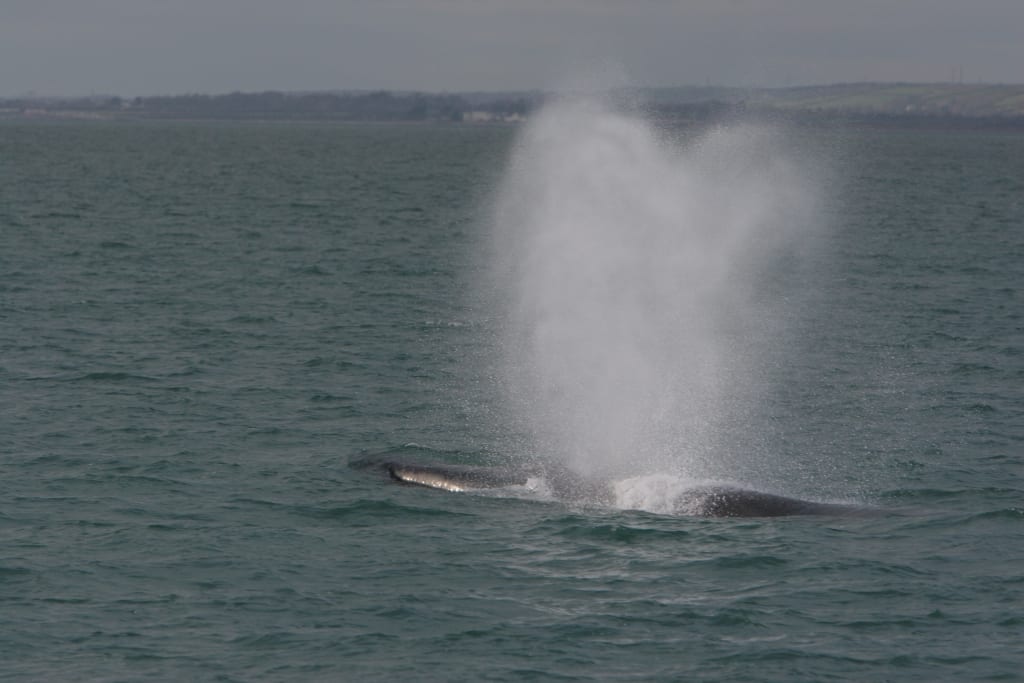We seem to have finally turned the corner, as for the 2nd consecutive year we have an increase in cetacean sighting records that have been reported to and validated by IWDG. As of our most recent sighting record we’ve documented 1,569 records of 10 species thus far in 2019; of which 8 were cetacean species and the remaining two were basking sharks (47 records) and a few leatherback turtle records.
At a glance all eight cetacean species were the usual inshore suspects, comprising in order of frequency: harbour porpoise, common dolphin, minke whale, bottlenose dolphin, humpback whale, fin whale, Risso’s dolphin and killer whale. So it is interesting that the scheme has reported none of the common offshore species such as Atlantic white-sided dolphins, long-finned pilot whales or sperm whales. Clearly we’ve got to try and encourage mariners who are spending time along the shelf edge to be more vigilant in both observations and reporting, as ideally we’d like to see more offshore sightings from deep water habitats in our dataset.
May was our busiest month for sightings with no less than 259 sighting records, which reflected on both the reliable showing of humpback whales along the Southwest coast and a run of very settled weather. Alas, our Autumn seems to have arrived rather early this year (in June) and the summer months remained disappointingly wet and windy in many of our hotspots, which limited the volume of reports, as people just couldn’t find the weather windows necessary for land or boat based sightings.
There have been many standout sighting events in 2019, ranging from porpoises in rivers, to big feeding aggregations of minke whales, to returning humpback cohorts over 20 years and even a fin whale in Dublin port, but for me 2019 will be remembered as the year we were visited by “Spirtle”, the young female bottlenose dolphin born in 2012 in the Moray Firth, Northeast Scotland. She was found live stranded on the 29th May 2016 and refloated on May 30th. She was next seen alive and seemingly well on the July 14th 2016 with the large wound on her right side. Since then, her wound has healed and morphed into a very large white patch on her right flank, and so when we got images from a sighting of small group of bottlenose dolphins working an area between Greystones and Dalkey between 14th -20th May 2019, it didn’t take long before her identity became known to us.

“Spirtle” ,Killiney Beach, Co. Dublin 20th May 2019 © Cairbre Ó Ciardha

Spirtle back “home” at the Moray Firth NE Scotland 17th Dec. 2019 © Charlie Philips
This small band of bottlenose was reported off Newcastle, Co. Wicklow on May 22nd and then a gap of 5 weeks followed till they appeared off Fenit Co. Kerry on June 28th. They were recorded in this immediate area on nine occasions until last seen on Sept. 19th again off Fenit by John Moriarty. And that seemed to be the end of the story until yesterday that is, when bottlenose dolphin photographer and researcher Charlie Philips contacted us to say he’d just photographed “Spirtle” and her mother back in the inner Moray Firth on Dec. 17th… her return home just in time for Christmas. A distance of just over 1,000 km.
It’s events like this which demonstrate the enormous contribution of Citizen Scientists in helping IWDG tell these stories, and highlight the importance of collaboration with overseas researchers and like-minded organisations.
So what of the coming Christmas holiday period?

Harbour porpoise pair off Howth Hd Dublin 6th Dec 2019 © Dave O’ Connor, Wolfhound Tours.
If we get a period of high pressure which generally brings cold, clear, polar air, then the whale watching in Ireland can be surprisingly good in mid- winter. As highlighted so well in Andrew Malcolm’s article a few days ago, if it’s large whales you’re interested in then you need to be willing to travel to the Waterford coast where traditionally fin whales and large aggregations of common dolphins will be tracking the spawning herring shoals and there is always the chance that they’ll have a few late season humpback in among them. For those in the Dublin area, in recent weeks there have been good numbers of porpoises seen and photographed by David O’ Connor between Balscadden and the nose of Howth on Howth Head. This image was taken by David from the cliff walk and shows a particularly well notched dorsal fin on this adult porpoise to rear, which should be easily recognisable if seen again over the holiday period… A nice photographic challenge!
Along the North coast there has been recent bottlenose dolphin activity in the North Antrim/Rathlin area and places like Donegal Bay and the Northwest are always worth checking out, especially given their recent bumper sprat harvest. That is assuming they haven’t all been converted to fishmeal and some was left for the local WILD life!
As we’ve always said, if you look, you will see, and those that look the most tend to see the most. Please let us know how you get on by reporting any sightings to us on www.iwdg.ie. On behalf of all of us in IWDG I’d like to take this opportunity to thank you all for your support over the year and we wish you a blubber rich 2020 with plenty of interesting sightings.
Pádraig Whooley
IWDG Sightings Officer

